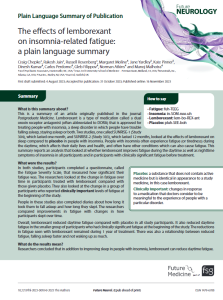Insomnia-related fatigue: a plain language summary looking at the effects of lemborexant
 This Plain Language Summary of Publication article from Future Neurology summarises the results from two studies, SUNRISE-1 and SUNRISE-2, which looked at the effects of lemborexant on sleep in people with insomnia. This summary, specifically, looks at whether lemborexant improves fatigue during the daytime as well as improving nighttime symptoms.
This Plain Language Summary of Publication article from Future Neurology summarises the results from two studies, SUNRISE-1 and SUNRISE-2, which looked at the effects of lemborexant on sleep in people with insomnia. This summary, specifically, looks at whether lemborexant improves fatigue during the daytime as well as improving nighttime symptoms.
Visit the Future Medicine using the link to read the article.
The original article on which this summary is based is called ‘Improvement in fatigue and sleep measures with the dual orexin receptor antagonist lemborexant in adults with insomnia disorder’ and was published in Postgraduate Medicine
Visit Taylor & Francis Online using the link to read the original article.
